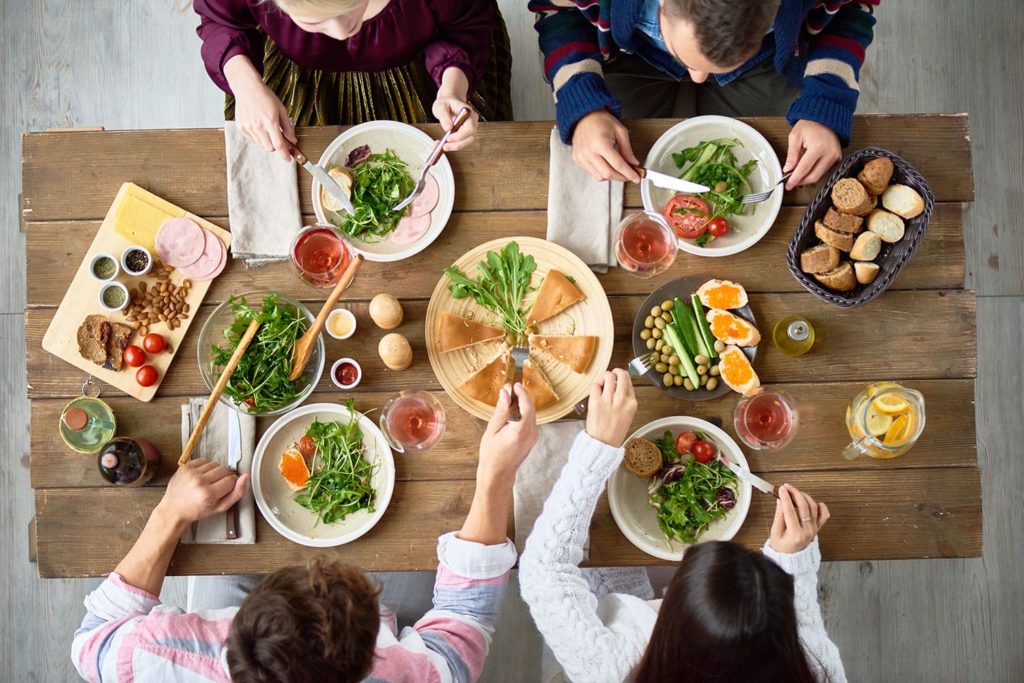Believe it or not, the holidays are fast approaching! As a parent, you certainly have your own childhood memories of the magic of the holidays, full of feasts and treats and sugar and spice! As parents ourselves, we understand the natural wish to develop fantastic holiday memories for your own children. As your integrative pediatrician and medical home in the Mile High City, however, we further understand the importance of attempting to keep your children on a healthy track, no matter how many temptations the holidays present. So in the spirit of combining health and holiday fun, we would like to share with you and your family some ideas for healthy eating.

Some General Practical Tips
- Offer healthy snacks: We all are only too aware how easy it is to eat sugary snacks and treats during the holiday season! One way to combat this tendency is to have healthier alternatives on hand to offer your children. Rather than cookies or sugary granola bars, offer your kids items such as cut up vegetables with homemade dips or dressings, fruits or nuts. Healthy, but still delicious!
- Homemade is generally better: Making your own holiday treats, rather than purchasing them, gives you the opportunity to better control fat, sugar and salt intake, while also potentially using more nutritious ingredients. Making your own holidays treats also provides the perfect opportunity to create cherished family traditions and memories, something that can be passed down from generation to generation!
- Set an example for your kids: As parents, we are always trying to model good behavior for our children–this applies to food, too. If you enjoy a treat, let your kids see through example the importance of reasonable serving portions and eating only until full. A valuable lesson for all to learn!
- Balance eating with physical activity: If you know that your children will be eating a large holiday meal, encourage them to get some exercise before and/or after the meal. Suggest they play or enjoy a walk together as a family in your neighborhood or one of the Denver metro area’s wonderful city parks.

Have A Plan for Holiday Events
- If you are going to be eating out, take the edge off your kiddos’ hunger and let them eat a healthy snack, such as fruits, nuts or a small piece of low-fat cheese, before the event.
- Limit food servings. Although there are different points of view, and depending on the age of your children, you could consider establishing a “one trip” rule, making it a policy that your children can make one trip through the food line but will then have to ask before going to get an extra serving of food. Whatever approach you take, however, the point is to help your kids learn moderation and to encourage them to eat only until full!
- Start a meal with fruits and vegetables. This will not only encourage your kids to make more healthy food choices, but may also help them to fill up and be less inclined to turn to unhealthy desserts and other such items to satisfy their hunger.
- Don’t allow your kids (or yourself) to not eat during the day, even if you know you will be eating a holiday feast later. Not eating for a long duration only increases the odds that you and your family will eat more at an event.
- Don’t eliminate desserts, but don’t over-indulge either. Although there may be a variety of desserts to choose from, encourage your child to pick one or two and in reasonable portion sizes. Let your kids eat their last sweet treat at least one hour before bedtime in order to minimize the chance that the sugar will disturb your child’s sleep and/or mood.
Consider Hosting Holiday Dinner
If you want to be able to exercise more control over your family’s eating during the holiday season, consider hosting a holiday meal! (Even if you don’t host, you can still ask if you can bring a dish so that you know there will be at least one healthy item at the meal.)
- Substitute ingredients to lighten up a dish: Regular broth can contain high amounts of sodium, so use low sodium broth instead. Other healthy substitutions include using plain non-fat Greek yogurt instead of sour cream, whole grains instead of white flour, bananas instead of butter, and herbs and spices instead of salt.
- Don’t buy a self-basting turkey: Self-basting turkeys are higher in sodium. To make a regular turkey moist, bake it with the skin on, then remove the skin once the inside of the turkey has reached 165 degrees Fahrenheit.
- Sneak in vegetables: Even if your kids don’t love veggies, the good news is that there are numerous opportunities to sneak them in because of the large variety of dishes served at holiday meals! For instance, consider adding kale to the stuffing, serve roasted vegetables (such as sweet potatoes, Brussel sprouts, carrots, onions and asparagus), use mashed sweet potatoes instead of a candied sweet potato casserole, add whole corn kernels to cornbread, or serve a squash casserole instead of the typical green bean casserole which can be heavy on fat.
- Use whole grain: There are a variety of bread dishes served during the holidays–think of the delicious home-made rolls and stuffing! If you’re preparing one of these dishes, use whole grains instead of white. For example, make or buy whole grain rolls, use whole grains in stuffing, and put whole-wheat croutons in salads. As you may know, whole grains have more fiber than white flour, which can help keep your and your kids’ weight down and hearts healthy.

Healthy Recipe Ideas
There are many traditional recipes, but it can be good (and healthier) to think outside of the box at the holidays (and the rest of the year, too)! Here are some terrific ideas we found while researching this blog:
- Rather than serving mashed potatoes with sour cream and butter, try serving mashed cauliflower seasoned with plain Greek yogurt for creaminess and with spices such as garlic, basil, and oregano. Substituting fat-free Greek yogurt for sour cream will save almost fifty calories and six grams of fat per ounce.
- Candied yams with marshmallows can seem almost like a dessert, so instead roast sweet potatoes with olive oil and cinnamon.
- Substitute rinsed, pureed black beans for flour in any baked good recipe, such as for brownies, thereby reducing the calories and increasing the fiber content. One cup of flour has 450 calories per cup; black beans have just 200 calories per cup. The substitution is on a one-to-one ratio.
- Substitute bananas for butter in baked recipes, without sacrificing taste and texture. One half cup of butter has 814 calories while the same amount of mashed banana has only 100 calories. The substitution ratio is one-to-one.
- Try substituting Stevia for regular sugar in your favorite holiday desserts. Stevia is an all-natural, zero-calorie substance that saves 774 calories per cup. This substitution is a one-to-one ratio. You can usually find Stevia next to the sugar at the grocery store.
We hope the above helps you and your family enjoy the magical holidays while staying as healthy as possible. Our integrative pediatric practice is not limited to conventional medicine, but also includes a more holistic approach using complementary and alternative sources, such as we have shared here. We wish you and yours joy and relaxation for the holidays, but please do not hesitate to contact us should the need arise!



Leave a Reply